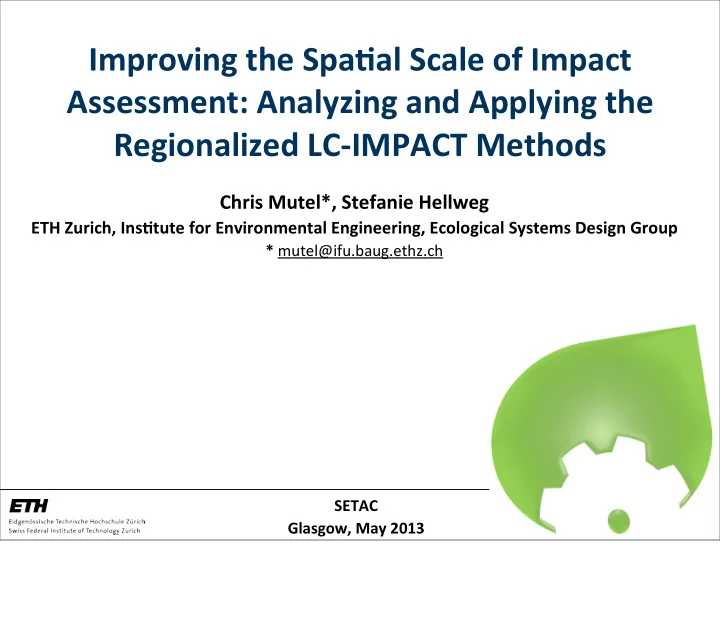

Improving ¡the ¡Spa0al ¡Scale ¡of ¡Impact ¡ Assessment: ¡Analyzing ¡and ¡Applying ¡the ¡ Regionalized ¡LC-‑IMPACT ¡Methods Chris ¡Mutel*, ¡Stefanie ¡Hellweg ETH ¡Zurich, ¡Ins0tute ¡for ¡Environmental ¡Engineering, ¡Ecological ¡Systems ¡Design ¡Group * ¡mutel@ifu.baug.ethz.ch SETAC Glasgow, ¡May ¡2013
Simplifica0on 2 This presentation is about improving and applying the systematic method to choose the spatial scale of impact assessment published in Mutel et al to the regionalized impact assessment methods developed in the LC-IMPACT project.
Two-‑step ¡methodology 1 Less ¡aggregated More ¡aggregated More ¡spa;al ¡units Fewer ¡spa;al ¡units 2 3 The basic technique is to apply a discretize the continuous surface of characterization factors at a number of levels of aggregation, to generate a set of candidate maps (step one). These candidate maps are then evaluated using some metric, and the candidate map that minimizes or maximizes the metric is chosen as the “best” spatial scale.
CF ¡spa0al ¡aggrega0on • Why ¡simplify? • Need ¡polygonal ¡areas ¡for ¡LCA ¡matrix ¡math • Indicate ¡appropriate ¡spa;al ¡resolu;on ¡to ¡LCI ¡dataset ¡ developers • Improve ¡CF ¡signal-‑to-‑noise ¡ra;o • Allows ¡genera;on ¡of ¡CF ¡uncertain;es 4 There are (at least) four reasons to simplify raster or otherwise disaggregated CF maps. First, it allows us to use our normal matrix-based LCA math (because we have a set of spatial units). Second, it tells inventory developers what spatial scale they need to think about for their datasets. Third, it helps interpretation and understanding by improving the signal-to- noise ratio. Finally, it gives us automatic generation of characterization factor uncertainties.
BeRer ¡discre0za0on • Equal-‑width ¡binning 5 The earlier approach ignored spatial relationships and simply binned the CF data based on the empirical CDF. The bins lines can be adjusted as a sensitivity check. Note that this is equal width in data percentages, not data ranges.
Machine ¡learning 6 Crea;ve ¡Commons: ¡Brian ¡Ma;s, ¡hMp://www.flickr.com/photos/brianjma;s/4333643093/ However, we can do better by borrowing techniques from the machine learning community.
Ward ¡hierarchical ¡clustering • Clusters ¡need ¡con;guity • Use ¡variance ¡minimiza;on ¡to ¡choose ¡new ¡clusters 7 One technique to discretize the (semi-)continuous CF surface map is Ward hierarchal clustering, which reaches a desired level of aggregation by picking contiguous clusters which minimize variance. We use the implementation in scikits-learn (tutorial).
Ward ¡clustering ¡is ¡beRer 8 Ward hierarchal clustering is much better than equal-width binning.
Forestry 9 Here is an example for carbon fluxes from forestry. The metric chosen to evaluate the di fg erent candidate maps remains minimization of spatial autocorrelation, as in Mutel et al.
Forestry 10 The clustered, or aggregated, CF values match quite well with the raw disaggregated values. Clustering seems to have found a good approximation of the underlying spatial scale of the impact assessment.
Forestry 11 A map of the chosen “best” spatial scale. This map shows us that clustering has found a strong dependence on country-level data.
Noise 12 With noise (in this case, the characterization factors for 2000-hz, averaged over the day), we get a similar minimization of spatial autocorrelation. We default to the smallest number of spatial units if there is a large minimized area.
Spa0al ¡complexity 13 However, this spatial scale has a large error.
Spa0al ¡complexity 14 The chosen “best” spatial scale has spatial units which contain highly variable disaggregated data.
Archetypes 15 An alternative to GIS-based regionalization are so-called archetypes, which provide simple categories for inventory information. One proposed scheme is for three levels of population density. In many cases, these archetypes can also be represented as spatial layers. Population density data from Gallego/EEA.
Popula0on ¡density ¡correla0on r 2 ¡= ¡0.19 16 Noise CFs are correlated with population density, though not perfectly (other factors such as climate also play a role in CF generation).
Archetype ¡error Average ¡|errors|: ¡0.53 Median ¡|errors|: ¡0.66 Average ¡|errors|: ¡0.38 Median ¡|errors|: ¡0.52 17 Using an archetype-based approach introduces more and wider error, but may be acceptable if it allows a better match with inventory data. Ward clustering, by its very nature, produces very nicely distributed errors.
Raster ¡data ¡in ¡LCA • Benefits • No ¡need ¡for ¡simplifica;on • Can ¡match ¡inventory ¡and ¡impact ¡assessment • Costs • So^ware ¡development • Complexity ¡in ¡understanding • Fundamental ¡ques;on ¡about ¡what ¡LCA ¡is • What ¡is ¡“good ¡enough”? 18 Another alternative may be the direct inclusion of raster data in LCIA methods or LCI datasets. This would increase software complexity but allow the direct use of the raw data. In my opinion, we have to ask ourselves what the real question is before we can try to answer it - what is good enough for LCA to provide decision support?
Conclusions • Ward ¡clustering ¡is ¡a ¡ good ¡approach ¡for ¡genera;ng ¡ candidate ¡maps • Heterogeneity ¡of ¡some ¡regionalized ¡LCIA ¡methods ¡ poses ¡challenges • Regionaliza;on ¡of ¡foreground ¡versus ¡background? • Work ¡on ¡advanced ¡regionalized ¡LCA ¡ so\ware ¡is ¡ ongoing ¡in ¡ Brightway2 ¡so^ware ¡tool • Scripts ¡for ¡LCIA ¡autocorrela;on ¡also ¡available 19
Thank ¡you ¡for ¡your ¡aRen0on. mutel@ifu.baug.ethz.ch chris.mutel.org brightwaylca.org bitbucket.org/cmutel/lcia-‑spa0al-‑autocorrela0on Thanks to LC-IMPACT method developers for the data, and the people of the EU and Switzerland for funding my research.
Recommend
More recommend